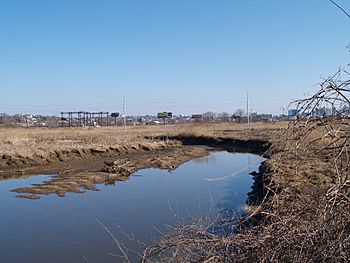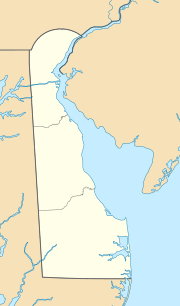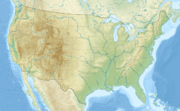Little Mill Creek (Christina River tributary) facts for kids
Quick facts for kids Little Mill Creek |
|
|---|---|

Little Mill Creek at Russell Peterson Wildlife Refuge
|
|
| Other name(s) | Tributary to Christina River |
| Country | United States |
| State | Delaware |
| County | New Castle |
| City | Wilmington |
| Physical characteristics | |
| Main source | Brandywine Creek divide about 0.5 miles west of Greenville, Delaware 315 ft (96 m) 39°46′40″N 075°36′15″W / 39.77778°N 75.60417°W |
| River mouth | Christina River Wilmington, Delaware 0 ft (0 m) 39°43′07″N 075°34′03″W / 39.71861°N 75.56750°W |
| Length | 3.29 mi (5.29 km) |
| Basin features | |
| Progression | generally south |
| River system | Christina River |
| Basin size | 9.25 square miles (24.0 km2) |
| Tributaries |
|
| Bridges | Carriage Road, Barley Mill Road, DE 48, Downs Drive, Faulkland Road, Rhode Island Avenue, DE 141, DE 2, DE 100, N Maryland Avenue, Major Street, I-95 |
Little Mill Creek is a small but important waterway in Delaware. It flows for about 3.29 mi (5.29 km) through New Castle County, Delaware. This creek eventually joins the larger Christina River. It's a natural home for many plants and animals in the area.
Other Names for the Creek
Throughout history, Little Mill Creek has been known by a few different names. The Geographic Names Information System lists these other names:
- Mill Creek
- Taswaijeeskil
- Tesswijreskijl
Where the Creek Starts and Ends
Little Mill Creek begins near a place called Greenville in New Castle County, Delaware. It starts close to the Brandywine Creek divide, which is like a high point separating two different river systems.
From its start, Little Mill Creek flows generally towards the south. Its journey ends when it meets the Christina River in Wilmington, Delaware.
The Creek's Surrounding Area
The area that Little Mill Creek drains is called its watershed. This watershed covers about 9.25 square miles (24.0 km2). This means all the rain that falls in this area will eventually flow into Little Mill Creek.
On average, the watershed receives about 46.5 inches (118 cm) of rain each year. About 14% of the land in this watershed is covered by forests. These forests help keep the water clean and provide homes for wildlife.



